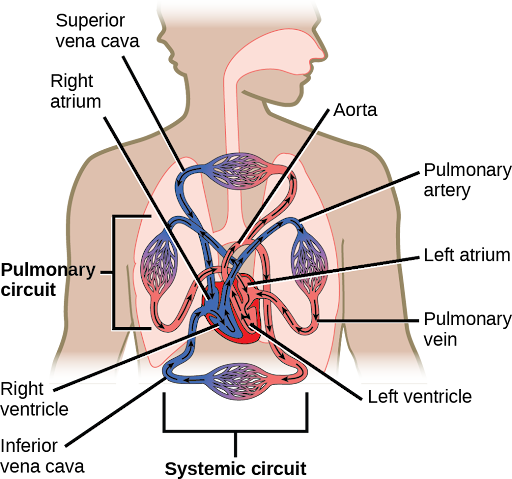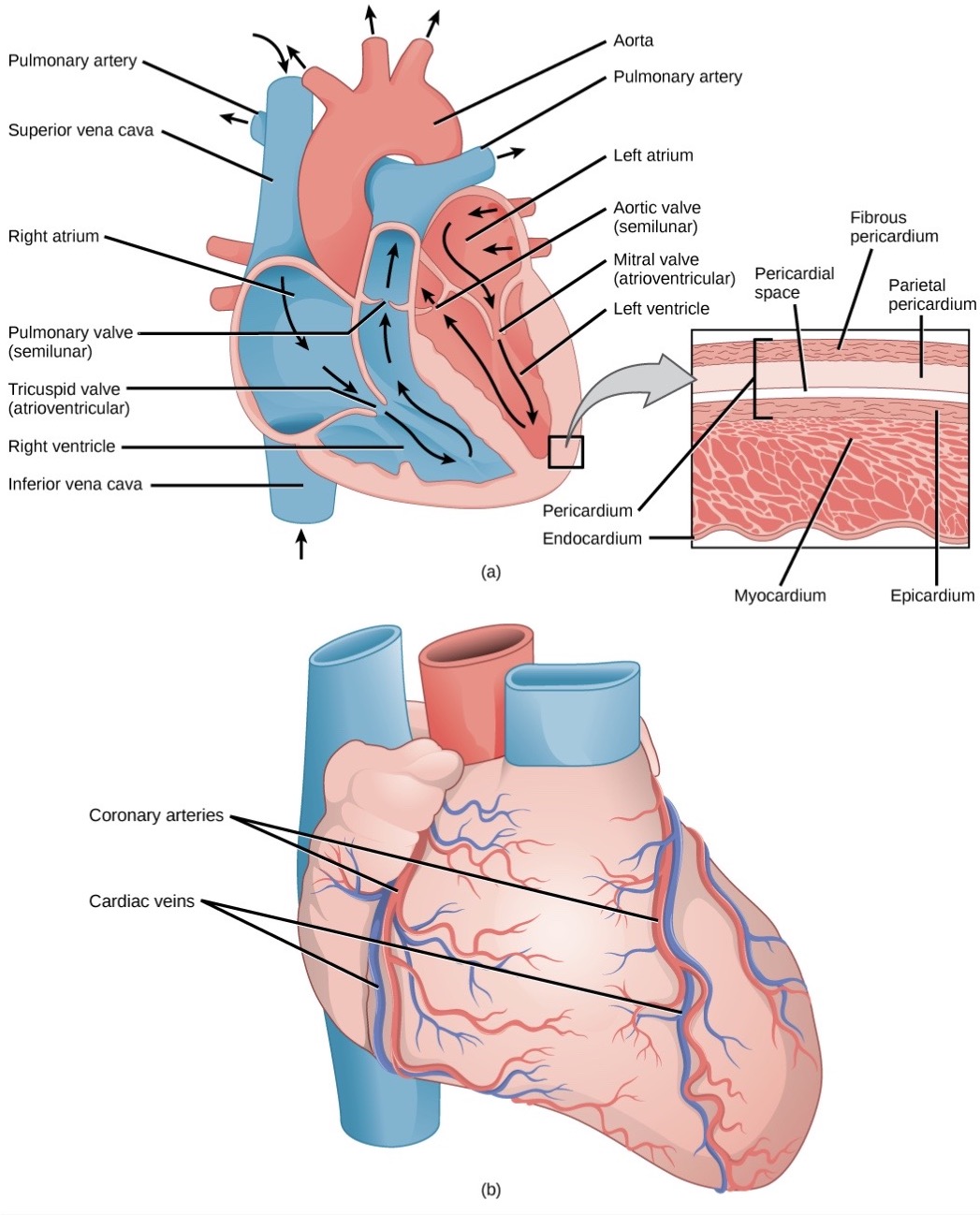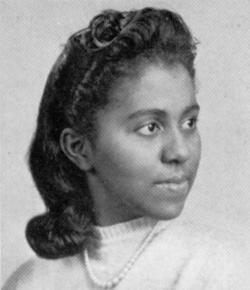The Mammalian Heart
Section Goals
By the end of this section, you will be able to do the following:
- Describe the structure of the heart and explain how cardiac muscle is different from other muscles
The heart is a complex muscle that pumps blood through the three divisions of the circulatory system: the coronary (vessels that serve the heart), pulmonary (heart and lungs), and systemic (systems of the body), as shown in Figure 1. Coronary circulation intrinsic to the heart takes blood directly from the main artery (aorta) coming from the heart. For pulmonary and systemic circulation, the heart has to pump blood to the lungs or the rest of the body, respectively. In vertebrates, the lungs are relatively close to the heart in the thoracic cavity. The shorter distance to pump means that the muscle wall on the right side of the heart is not as thick as the left side which must have enough pressure to pump blood all the way to your big toe.

Did I Get It?
Structure of the Heart
The heart muscle is asymmetrical as a result of the distance blood must travel in the pulmonary and systemic circuits. Since the right side of the heart sends blood to the pulmonary circuit, it is smaller than the left side, which must send blood out to the whole body in the systemic circuit, as shown in Figure 2. In humans, the heart is about the size of a clenched fist; it is divided into four chambers: two atria and two ventricles. There is one atrium and one ventricle on the right side and one atrium and one ventricle on the left side. The atria are the chambers that receive blood, and the ventricles are the chambers that pump blood. The right atrium receives deoxygenated blood from the superior vena cava, which drains blood from the jugular vein that comes from the brain and from the veins that come from the arms, as well as from the inferior vena cava which drains blood from the veins that come from the lower organs and the legs. In addition, the right atrium receives blood from the coronary sinus which drains deoxygenated blood from the heart itself. This deoxygenated blood then passes to the right ventricle through the atrioventricular valve or the tricuspid valve, a flap of connective tissue that opens in only one direction to prevent the backflow of blood. The valve separating the chambers on the left side of the heart valve is called the bicuspid or mitral valve. After it is filled, the right ventricle pumps the blood through the pulmonary arteries, bypassing the semilunar valve (or pulmonic valve) to the lungs for re-oxygenation. After blood passes through the pulmonary arteries, the right semilunar valves close, preventing the blood from flowing backward into the right ventricle. The left atrium then receives the oxygen-rich blood from the lungs via the pulmonary veins. This blood passes through the bicuspid valve or mitral valve (the atrioventricular valve on the left side of the heart) to the left ventricle where the blood is pumped out through the aorta, the major artery of the body, taking oxygenated blood to the organs and muscles of the body. Once blood is pumped out of the left ventricle and into the aorta, the aortic semilunar valve (or aortic valve) closes, preventing blood from flowing backward into the left ventricle, this overall pattern of pumping is referred to as double circulation and is found in all mammals.

The heart is composed of three layers; the epicardium, the myocardium, and the endocardium, illustrated in Figure 2. The inner wall of the heart has a lining called the endocardium. The myocardium consists of the heart muscle cells that make up the middle layer and the bulk of the heart wall. The outer layer of cells is called the epicardium, of which the second layer is a membranous layered structure called the pericardium that surrounds and protects the heart; it allows enough room for vigorous pumping but also keeps the heart in place to reduce friction between the heart and other structures.
The heart has its own blood vessels that supply the heart muscle with blood. The coronary arteries branch from the aorta and surround the outer surface of the heart like a crown. They diverge into capillaries, where the heart muscle is supplied with oxygen before converging again into the coronary veins to take the deoxygenated blood back to the right atrium, where the blood will be re-oxygenated through the pulmonary circuit.
To learn more about what the heart looks like, how blood flows through the heart, and how the heart beats, visit the site How the Heart Works from the National Heart, Lung and Blood Institute.
The heart muscle will die without a steady supply of blood. Atherosclerosis is the blockage of an artery by the buildup of fatty plaques. Because of the size (narrow) of the coronary arteries and their function in serving the heart itself, atherosclerosis can be deadly in these arteries. The slowdown of blood flow and subsequent oxygen deprivation that results from atherosclerosis causes severe pain, known as angina, and complete blockage of the arteries will cause myocardial infarction: the death of cardiac muscle tissue, commonly known as a heart attack.
Scientist Spotlight
 Marie M. Daly was the first black woman to receive a Ph.D. in Chemistry. She conducted groundbreaking research that associated cholesterol, high blood pressure, and the causes of atherosclerosis, which led to a deeper understanding of ways to prevent heart attack and treat heart disease. She has been honored by the American Chemical Society (ACS) on their National Historic Chemical Landmarks site dedicated to chemists and chemistry that has transformed our lives. You can also read more about her life and work from the Science History Institute’s Scientific Biographies pages!
Marie M. Daly was the first black woman to receive a Ph.D. in Chemistry. She conducted groundbreaking research that associated cholesterol, high blood pressure, and the causes of atherosclerosis, which led to a deeper understanding of ways to prevent heart attack and treat heart disease. She has been honored by the American Chemical Society (ACS) on their National Historic Chemical Landmarks site dedicated to chemists and chemistry that has transformed our lives. You can also read more about her life and work from the Science History Institute’s Scientific Biographies pages!Did I Get It?
CC Licensed Content, Shared Previously, Included in An Introduction to Animal Physiology
- Biology 2e. Authors: Mary Ann Clark, Matthew Douglas and Jung Choi. Provided by: OpenStax CNX. Located at: Biology 2e. License: CC BY: Attribution 4.0.
- Biology for Majors II. Authors: Shelly Carter and Monisha Scott. Provided by: Lumen Learning. Located at: Biology for Majors II | Simple Book Production. License: CC BY: Attribution 4.0.

